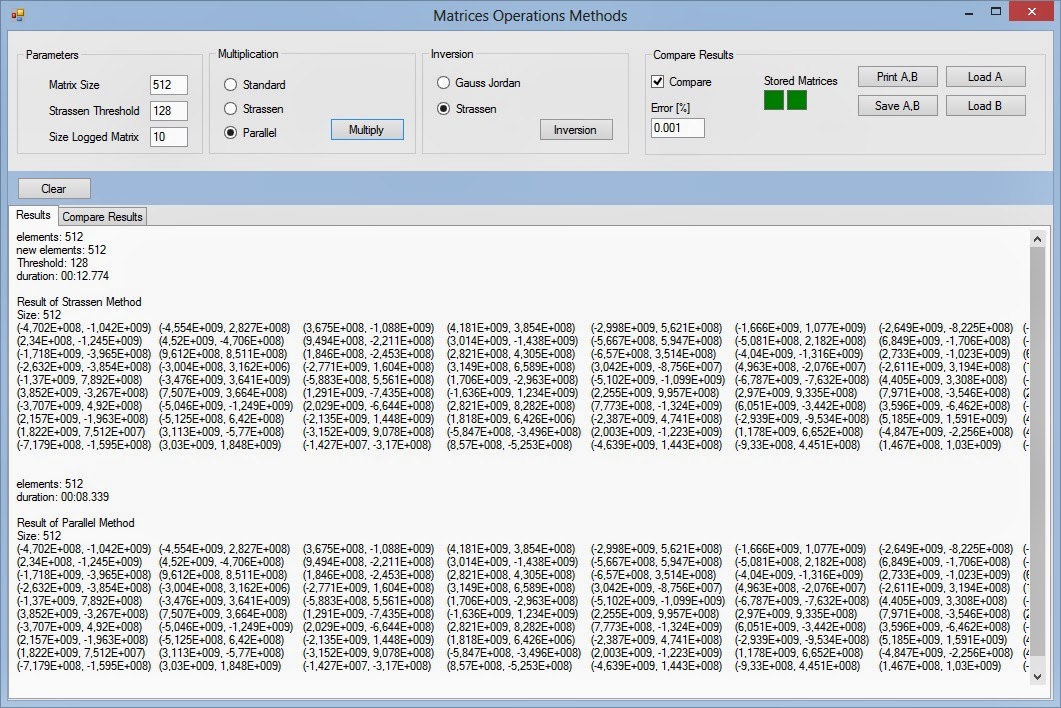Fortunately, when I studied Strassen for multiplication there was on the book an interesting conclusion: With this “fast” matrix multiplication, Strassen also obtained a surprising result for matrix inversion.
This very intriguing phrase bring me to the following formula:
R1 = Inverse(a11)
R2 = a21 x R1
R3 = R1 x a12
R4 = a21 x R3
R5 = R4 - a22
R6 = Inverse(R5)
c12 = R3 x R6
c21 = R6 x R2
R7 = R3 x c21
c11 = R1 - R7
c22 = -R6
So what I learned was that it is possible to obtain the matrix (multiple of 2^n) inversion from some “lighter” operations. I implemented this algorithm and compared it with the Gauss Jordan one.
Comparing those two algorithms, I obtained, using my notebook, these results:
Matrices 512x512 of Complex (double, double)
GJ; 24sec
Strassen: 19sec
20% time less
Matrices 1024x1024 of Complex (double, double)
GJ; 3min 02sec
Strassen: 2min 05sec
38% time less!
Used Invertion Methods
Gauss Jordan LU decomposition
public static Complex[,] GaussJordanInvertion(Complex[,] mat, BackgroundWorker bw = null)
{
//Gestione notifica progressione
int iPerc = 0;
int iMax = mat.GetLength(0);
int iDone = 0;
Complex[,] res;
res = MatrixGeneric.Create<complex>(iMax);
res = (Complex[,])mat.Clone();
int[,] indxc;
indxc = MatrixGeneric.Create<int>(iMax, true);
int[,] indxr;
indxr = MatrixGeneric.Create<int>(iMax, true);
int[,] ipiv;
ipiv = MatrixGeneric.Create<int>(iMax, true);
Complex big;
Complex pivinv;
Complex dum;
int iRow = 1;
int iCol = 1;
for (int i = 1; i <= iMax; i++)
ipiv[i, 1] = 0;
for (int i = 1; i <= iMax; i++)
{
big = 0;
for (int j = 1; j <= iMax; j++)
if (ipiv[j, 1] != 1)
for (int k = 1; k <= iMax; k++)
{
if (ipiv[k, 1] == 0)
{
if (Complex.Abs(res[j, k]) >= Complex.Abs(big))
{
big = Complex.Abs(res[j, k]);
iRow = j;
iCol = k;
}
}
else if (ipiv[k, 1] > 1)
{
//Error "Singular Matrix -1"
}
}
++(ipiv[iCol, 1]);
if (iRow != iCol)
{
for (int l = 1; l <= iMax; l++)
Swap(res[iRow, l], res[iCol, l]);
}
indxr[i, 1] = iRow;
indxc[i, 1] = iCol;
if (res[iCol, iCol] == 0)
{
//Error "Singular Matrix -2"
}
pivinv = 1 / res[iCol, iCol];
res[iCol, iCol] = 1;
for (int l = 1; l <= iMax; l++)
res[iCol, l] = res[iCol, l] * pivinv;
for (int ll = 1; ll <= iMax; ll++)
if (ll != iCol)
{
dum = res[ll, iCol];
res[ll, iCol] = 0;
for (int l = 1; l <= iMax; l++)
{
res[ll, l] = res[ll, l] - res[iCol, l] * dum;
}
}
}
for (int l = iMax; l > 0; l--)
{
if (indxr[l, 1] != indxc[l, 1])
for (int k = 1; k <= iMax; k++)
Swap(res[k, indxr[l, 1]], res[k, indxc[l, 1]]);
}
return res;
}
Strassen
public static Complex[,] Inverse(Complex[,] a, int iThreshold = 128)
{
int iOriginalSize = a.GetLength(0);
int iFmtSize = GetSize(a.GetLength(0));
Complex[,] A = a;
int iSize = A.GetLength(0);
int iHalfSize = iSize / 2;
if (iSize <= iThreshold) {
return GaussJordanInvertion(a);
}
Complex[,] A11 = null;
Complex[,] A12 = null;
Complex[,] A21 = null;
Complex[,] A22 = null;
Complex[,] R1 = null;
Complex[,] R2 = null;
Complex[,] R3 = null;
Complex[,] R4 = null;
Complex[,] R5 = null;
Complex[,] R6 = null;
Complex[,] R7 = null;
Complex[,] C11 = null;
Complex[,] C12 = null;
Complex[,] C21 = null;
Complex[,] C22 = null;
A11 = GetMatrixPortion(A, iHalfSize, 1, 1);
R1 = Inverse(A11);
A21 = GetMatrixPortion(A, iHalfSize, iHalfSize + 1, 1);
R2 = Mul_Strassen(A21, R1, iThreshold);
A12 = GetMatrixPortion(A, iHalfSize, 1, iHalfSize + 1);
R3 = Mul_Strassen(R1, A12, iThreshold);
R4 = Mul_Strassen(A21, R3, iThreshold);
A22 = GetMatrixPortion(A, iHalfSize, iHalfSize + 1, iHalfSize + 1);
R5 = Subtract(R4, A22);
R6 = Inverse(R5);
C12 = Mul_Strassen(R3, R6, iThreshold);
C21 = Mul_Strassen(R6, R2, iThreshold);
R7 = Mul_Strassen(R3, C21, iThreshold);
C11 = Subtract(R1, R7);
C22 = Multiply(R6, -1);
Complex[,] c = MatrixGeneric.Create<complex>(iSize, iSize);
for (int i = 1; i <= iHalfSize; i++)
{
for (int j = 1; j <= iHalfSize; j++)
{
c[i, j] = C11[i, j];
c[i, j + iHalfSize] = C12[i, j];
c[i + iHalfSize, j] = C21[i, j];
c[i + iHalfSize, j + iHalfSize] = C22[i, j];
}
}
A11 = null;
A12 = null;
A21 = null;
A22 = null;
R1 = null;
R2 = null;
R3 = null;
R4 = null;
R5 = null;
R6 = null;
R7 = null;
C11 = null;
C12 = null;
C21 = null;
C22 = null;
GC.Collect();
return c;
}
Remember that the input matrix shoud be a 2^n multiple, if not! complete it with 0 and 1 on the diagonal.




